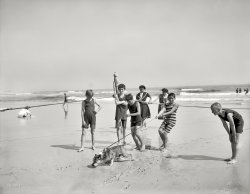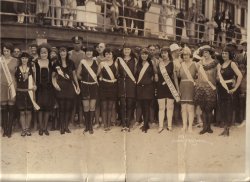
MAY CONTAIN NUTS

Search Shorpy
SHORPY ART

Framed or unframed, desk size to sofa size, printed by us in Arizona and Alabama since 2007. Explore now.
Join and Share
Ad-Free Shorpy
Shorpy is funded by you. Patreon contributors get an ad-free experience.
Learn more.

Recent comments
- Pinstripes in the Tower
- Sound enhancement
- 3438 in '38
- Second Career
- Their days are numbered
- Only the Sensor
- Train control mechanism
- Rarest of the Rare?? & Classy 3400 Class
- Control Mechanism
- Those standpipes
- Wrenches
- International D-40 I believe
- Job prospects
- You had me at Train
- Land of the free
- Broad-Exchange Bldg
- Parking innovation
- The old block
- "Peck turned a sweet propeller"
- National Bank Building
- Notch shot
- Straight ahead (right, left, left, right)
- Ship lifespans
- New service
- You Say Station, I Say Potato ...
- Iron Age
- Thank you, Cornelius Vanderbilt
- Grand Central Terminal
- If they made a movie of it
- Obsolete by then.
Member Photos
The Shorpy
Printporium
Printporium
Search Shorpy
Search results -- 30 results per page
- Boardwalk Rollers: 1905
- Atlantic City circa 1905. "The Shelburne, Michigan Avenue at Boardwalk." 8x10 inch dry ... to have my kids push me around in!
(The Gallery, Atlantic City, DPC) ... Posted by Dave - 03/22/2017 - 11:58am -
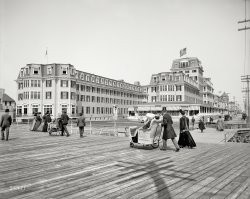
- The Big Hotels: 1915
- Atlantic City, N.J., ca. 1915. "Bathing in front of the big hotels -- Traymore [right] ... scanned, not poorly edited. - Dave]
(The Gallery, Atlantic City, DPC, Swimming) ... Posted by Dave - 07/20/2012 - 3:42pm -
![The Big Hotels: 1915 Atlantic City, N.J., ca. 1915. "Bathing in front of the big hotels -- Traymore [right] and Marlborough-Blenheim." Detroit Publishing glass negative. View full size.
Gotta AskAnyone know or remember why the M-B hotel has those two vertical elements? What were they for?
LovelyI really love old beach photos. They really makes me feel I'm right there. Maybe I was born in the wrong age. BTW, boys didn't go to the beach to watch girls, I guess.
Just before ka-boom-boomJust before they demolished the Traymore, my parents decided that we would go for a vacation and stay in the grand old hotel because it had once been such a fine place of its day. (Or maybe the management were renting the rooms at half price, since the end was near, and my father covered up his cheapness with the story of how we had to see that bit of history before it was gone).
By that time it was rather a dump. You didn't get a shower in your room. It was down at the end of the hall, and you had to wait your turn in that hallway.
What passed for luxury in the Traymore's time was really primitive.
It looked far better from the outside than the inside.
Did everyone rent bathing suits then?It seems there was only one style for each gender.
Helmar SmokesI never heard of them, but from the looks of their ad, they were popular. Probably a nickel a pack. And those suits and dresses at the beach just crack me up. Such different times.
Over-the-top Art Nouveau-ish hotelWhat grand architecture, in a Moorish style, right on the beach.
Helmar HeightsThat is quite the cigarette billboard. The spare construction of that is really interesting and kind of beautiful. I'd love to see one of those old signs up close. The elaborate edges make it look like the whole thing was somehow rubber stamped on the photo itself. Neat.
Aside from that, I love these old beach pictures. It's a little difficult to get past the bathing costumes, but once you do, it's amazing how similar it looks to a modern beach scene--splashing, talking, sunbathing (and the few protecting themselves from the sun). I guess people have always behaved in similar ways in sand and surf.
How many went down with heatstroke?I am always amazed at these beach photos. It is just beyond me to even imagine what it would be like to spend the day at the beach in a full suit, starched collar, tie and leather shoes. And all that before modern breathable lightweight fabrics.
I do not even want to try and think what it must have been like for the ladies in those dresses.
Ping Pong, Pilotis and GenesisFrom the enlargement emerge tantalizing details of some largely forgotten characteristics of the sandy playground.
A few doors left of Brady's Baths sits a concession stand with a sign for "Japanese Ping Pong." Not table tennis, but a typical arcade game of the era. It seems to have been a flatter, shorter-lived cousin to skee-ball. A.T. Hayashi appears in a 1920 directory as the proprietor, also operating one of the more numerous and better documented Japanese bric-a-brac shops.
"Piloti" is a bit of insider jargon that architectural critics used to describe each of the distinctive boardwalk-end columns on the Blenheim section of the Marlborough-Blenheim. The four-sided pylons were ecstatic expressions of architect William L. Price's confidence in the great things that can be done with reinforced concrete. Functional, too: the hotel was built with a longer tourist season in mind, and great fireplaces sent smoke up the chimneys within each pylon. The Historic American Buildings Survey has photos.
The hard-to-read, double-sided electric sign to the left of the Blenheim is set back from the boardwalk. Each side displays "Creation of the World." Don't know if the exhibit toured, but it sounds like a serious affair. Presumably the sign in our 1915 photo refers to the same show described in a booster magazine, The Suburbanite. From what looks to be the poorly edited September 1908 issue:
The greatest attraction near Young's Million-Dollar Pier, is the Scenographic illustration of "The Creation of the World," showing he (sic) evolution of the Universe emerging from Chaos, no (sic) birth of the World, and the Creation of man.
The Creation of the World occupies a large steel and concrete building on the boardwalk. The Creation of the World is a two hundred and fifty thousand dollar production, the largest Scenograph ever produced, it is far ahead of anything of this nature given in any other place.
[Imperfectly scanned, not poorly edited. - Dave]
(The Gallery, Atlantic City, DPC, Swimming)](https://www.shorpy.com/files/images/4a23893a.thumbnail.jpg)
- Marjory - Miss Toronto 1923
- ... photo (call it part 2). And what is the pageant? Miss Atlantic City maybe?
The Cop What really gets me is the cop to our left of Miss ... Posted by EgoSlaier - 09/22/2011 - 11:38pm -
- Bathing Beauties: 1905
- ... the life buoy actually was. Any ideas?
(The Gallery, Atlantic City, DPC, Pretty Girls, Swimming) ... Posted by Dave - 12/04/2012 - 11:12am -
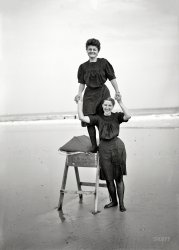
- Flyover: 1928
- ... long lineage of aircraft, cruised triumphantly up the Mid-Atlantic Coast today to show herself to millions of Americans who had followed ... spectacle. Continuing straight through the heart of the city, the dirigible swung through the northwest section over the German Embassy ... Posted by Dave - 07/17/2012 - 10:23pm -
![Flyover: 1928 "Graf Zeppelin over Capitol." The German airship on its visit to Washington in October 1928. National Photo Co. Collection glass negative. View full size.
I knew Cheney was rightObama has left us undefended!
Do I sense a..Homeland Security alert? Cue the F-18's.
FalloutWhite House Military Director Dewey Tellum immediately apologized for the incident, and the German government has promised to cover the entire $88.95 cost of the promotional stunt.
Oct. 15, 12:30 p.m.
Washington Post, Oct 16, 1928
Battle With Winds Marked Air Voyage
Log of Transatlantic Flight Tells Tale of
Struggle Against Elements.
New York, Oct. 15 (A.P.). - Graf Zeppelin, proud aristocrat of a long lineage of aircraft, cruised triumphantly up the Mid-Atlantic Coast today to show herself to millions of Americans who had followed with intense interest and some anxiety the progress of her record breaking voyage from Friedrichshafen, Germany.
The great silver ship made her bow to the waiting continent at 9:45 o'clock this morning, Eastern standard time, when she was sighted from Cape Charles, Va., northern promontory of the entrance to Chesapeake Bay. Behind her were not only 6,000 miles of land and water, but anxious moments when a damaged horizontal fin had forced her to reduce speed, and long hours of battling winds that were conspiring to keep her from the goal.
Triumphant over wind, weather and ocean, she slipped over the American coast at 10:10 a.m. at a point six miles north of Cape Charles, and from then on, with the journey's end in sight, her sturdy motors bore her comfortably over the densely populated coastal plain.
She paid her formal respects to Washington at about 12:30 p.m. sliding over the Capitol and White House beneath an overcast sky, and then slipped north to visit Baltimore, Wilmington, Philadelphia, Trenton and New York, passing as she went many smaller communities, which like their more populous neighbors, saluted the victorious voyager from street and housetop.
...
Washington first saluted the Graf Zeppelin at 12:21 when she approached from the east over the Capitol. As she circled above the Government buildings, sharp-eyed naval experts noticed the hole in her port stabilizer - the rent that had caused the anxiety last Saturday.
President Coolidge took time to have a look at Graf Zeppelin. Leaving his desk in the White House executive office, he stepped outdoors, bareheaded, watched the dirigible for a moment, as everybody else was doing, and then went back to work.
...
First Transoceanic VoyageThis is the Graf after it made the first flight over the Atlantic for an aircraft with paying passengers. It was also notable for damage done to the fabric of the port horizontal stabilizer, which was recovered and lashed tight by volunteers in flight.
Due to the newspaper headlines there was a huge crowd assembled at Lakehust when she arrived. Also a ticker-tape parade for Hugo Eckner and his crew in Manhattan and a reception by President Coolidge in the White House.
My mom saw it fly over her house on the eastern shore of Virginia as a child. She said it filled the sky.
It was not uncommon for airships to fly at an altitude lower than their length. The Graf was 787 feet long. Big enough to "fill the sky!"
PANIC!!!Can you imagine the havoc that would be caused if this happened today?
WOW!Of all the great pictures I've seen here in Shorpy (and I've seen quite a few!) this has to be one of the most striking. Thank you very much for sharing it with us!
48 States in the FlagIn 1928, there were, in fact, 48 States in the Union. Someone up top needs to retake history class.
[That may have been someone's idea of drollery. Or trollery. - Dave]
"Sally ship!"Something seems odd about the comparative views of the Capitol building and the ship. It looks as though she's making a sharp turn, but it doesn't seem likely that a zeppelin's speed could ever make her heel like that. Do the crew need to shift some ballast?
[There seems to have been quite a bit of dipping and circling involved. - Dave]
The Zeppelin entered Washington from the southeast, passing close to the Capitol, to which it dipped in salute as hundreds emerged from the House and Senate office buildings to view the spectacle. Continuing straight through the heart of the city, the dirigible swung through the northwest section over the German Embassy on Massachusetts Avenue, down past the State, War and Navy Building toward the Washington Monument.
By this time its altitude was estimated at about 1,000 feet. It swung easily with a slight roll, the rip in its port fin plainly showing.
It circled the Monument, passing almost over it and dipping in salute. She then turned her nose to the northeast and went directly over the White House, where she again dipped in formal salute and then straightened away toward Baltimore on her way to New York and Lakehurst.
Run for your lives!!It's heading for the Capitol!!
(five minutes later)
Keep on running! It's halfway there!!
Fake PhotoPhoto is obviously fake. Flag doesn't even have 50 stars on it. Duh.
D'oh! Fake Photo?Let's see ..... 1928 ..... hmmmm.... how many states in the Union?
Hat Crime"he stepped outdoors, bareheaded ... "
A scandal ensued.
Atop the domeYou know, I've probably seen a zillion pictures of the US Capitol in my lifetime, but this is the first time (probably because of the object hovering over it, and because I'm looking at the photo in full size format) that my eyes were drawn to the statue on top. I'm sure I've seen it with my eyes, but not with my comprehension.
I had to look it up myself to get a closer look at it. It's a statue called "Armed Freedom" and the best shot of it that I could find was, oddly enough, at AllPosters.com.
ProgressThis event was hailed as momentous, and a mere 41 years later, America would plant a 50-star flag on the Moon with space flight. The Moon! In only 41 years after a dirigible was touted as progress!
Up in the airThe photo looks like a montage to me. The image of the Zeppelin is exactly the same as the image on the newspaper front page, which was obviously taken while looking up as it flew over.
[The propulsion pods are lined up vertically in the Capitol photo. Not so in the newspaper photo. Obviously two different views. Also note that the haze over the zep in the Capitol photo blends in very well with the haze in the rest of the sky. Our source here is a glass negative, as opposed to a print on paper. - Dave]
The GrafWhat a beautiful ship. If I could take part in one event in history, I would want to be a passenger on the Graf Zeppelin's around-the-world voyage in 1929.
(The Gallery, D.C., Natl Photo, Zeppelins & Blimps)](https://www.shorpy.com/files/images/27630u.thumbnail.jpg)
- Ice Cream Every Day: 1920
- ... United States in 1862. For 24 year he lived in New York city and in Cincinnati. Since 1886 he had identified himself with Washington. ... doing research for a novel for kids that takes place in Atlantic City in the 1930's. I need ice cream flavors of the 1930's. Any ... Posted by Dave - 08/07/2012 - 10:25pm -
![Ice Cream Every Day: 1920 Washington, D.C., 1920. "J.C.L. Ritter. Carry Ice Cream truck." A brand-new Walker Electric. View full size. National Photo Co. Collection glass negative.
Walker ElectricInteresting truck here; it looks like it has holes to mount headlights but no headlights are mounted; solid disk wheels that imitate wooden spokes; padded backrest but no seat cushion. Very cool (no pun intended) shot of an early delivery vehicle.
[Seems to have just been painted. - Dave]
"Eat a plate of ice cream every day"And don't forget a glass of cake on the side.
Albert CarryAlbert Carry, the owner of Carry's Ice Cream, was a notable Washington entrepreneur. According to his obituary ( Washington Post, Feb 16 1925)
He was born in Haechinzen, Germany, in 1852 and came to the United States in 1862. For 24 year he lived in New York city and in Cincinnati. Since 1886 he had identified himself with Washington. He purchased the old Jueneman brewery and in 1889 sold the plant and organized the National Capitol Brewery Company, which he turned into the Carry Ice Cream Company. The past few years he has been active in banking and realty business in which he associated with him his two sons, Charles A. Carrey and Joseph G. Carrey
He apparently switched from the brewery to ice cream business as a result of prohibition. His ice cream company was located at 1337 D street southeast. He lived a few blocks away at 135 Twelfth street southeast. In the 1960s the site of the brewery/ice cream plant was sold to Safeway and has been a grocery store since then.
Much more about Albert Carry and family can be found at the
Capitol Hill History Project.
Heavy DutyCheck out how many leaves are in each axle spring, and the amount of compression at the bottom of each solid tire. I wouldn't expect such a small truck to be so heavy, but then this truck probably had quite a load of ice to keep things frozen. Hmm, and this is an electric truck maybe, judging by what might be huge battery boxes between the axles?
Anonymous #2: I'd love a cup of hot prime rib to wash it all down.
Refrigerated TrucksAccording to Wikipedia "It was not until the middle of the 20th century that refrigeration units were designed for installation on tractor-trailer rigs (trucks or lorries)." So I doubt this truck was refrigerated, maybe the box simply protected the fuel tank.
[There is no fuel tank. It's an electric truck. Doesn't anyone read the captions? And it would be refrigerated with dry ice. - Dave]
Contraption?My first impression was "wow, that's a contraption". The more I look at it, the more I am impressed with the workmanship and engineering evident in this vehicle. State of the art for that time.
DSS
Future TruckThis was a pretty forward thinking company, putting the telephone number on their trucks. Pity the same technology for making electric delivery trucks is not available today. If Ford, GM or Chrysler could manage that same task, they would rolling in so much money... Just a US mail delivery vehicle contract alone would make one of those companies a mint.
[The big electric delivery trucks disappeared from the scene because gasoline and diesel trucks gave better value. Which is still the case today. - Dave]
Great-GranddadMy grandmother (born in 1912) told me many stories about her engineering father, John Stubbe, who developed some electric cars. He later worked for the Locomobile company, which made electric buses for hotels and tourists. Not only were diesel and gas more efficient, but electric cars (not the trucks) were seen as something fit to drive by ladies, because they were safe and very slow and didn't go too far. That must not have sat too well with his wife, who was one of the first women drivers in Pittsburgh. Her touring car ran on gas. John Stubbe ended up leaving the electric car industry and worked on selling and maintaining gasoline vehicles on Baum Blvd in Pittsburgh.
[The main appeal electric cars had for women was no transmission, hence no gearshifting. And no cranking. All of which required an unladylike amount of exertion. NYT article on Jay Leno's Baker Electric. - Dave]
Batteries Not Included1918 Walker Electric Truck 3.5 ton chassis, Model P:
Weight: 5,600 lbs
Top Speed: 12 mph empty, 9 mph loaded
Range: 40 - 50 miles per charge
Price: $3,600 (batteries not included)
Batteries: 44 cells
Type: forward-control, open-enclosed cab 4x2
Serial No.: 1686
Wheelbase: 131 inches
Engine: Westinghouse electric motor mounted in rear axle
Transmission: none
Rear Axle: Walker hollow axle with integral electric motor, spur type gear reduction, 15:59 ratio
Front Axle: I-beam
Springs: semi-elliptic leaf, front and rear
Brakes: mechanical, external contracting on rear wheels
Steering: left side wheel, Ross steering gear
Wheels: Walker cast steel solid disc
Tires: 36" x 5" front and dual rear
Walker Electric Vehicle Co. built electric and gasoline-electric hybrid trucks from 1918 or earlier until at least 1942 in Chicago. The same marque may have been manufactured by the Automobile Maintenance Co. prior to this. A 1918 Model P 3.5-ton open cab version (serial number 1686) is on display at the Hays Antique Truck Museum at Woodland CA. The Walker 1 ton balance drive electric truck was used for local delivery service. The van is driven by an electric motor developing 3 1/2 h.p. with a range of around 50-60 miles on a single charge and could reach speeds of 12 mph. The only known working example, owned by Harrods Limited of Knightsbridge, London, still takes part in the annual historical commercial vehicle London-to-Brighton run.
http://www.econogics.com/ev/evhistw.htm
No hurryThundering along at 9 mph when loaded, I would think I would choose a faster mode of transport for ice cream, even with the dry ice as refrigeration. I doubt that they went very far. Anyone for ice cream soup?
[Dry ice and the insulated refrigerator body would keep your ice cream cold all day. The same method still used by a lot of Good Humor vendors. - Dave]
Experts . . .A minute and a half looking at an old pic (not seeing the caption) and everybody "knows" exactly what it is, how it worked (and when) and how everything was back in the day. Caption? . . . we doan need no stankin' caption.
Foy
Las Vegas
I Scream, You ScreamI'm doing research for a novel for kids that takes place in Atlantic City in the 1930's. I need ice cream flavors of the 1930's. Any suggestions? Thanks! Love the pick of the Ritter Truck!
[Search eBay for ice cream ads. - Dave]
(The Gallery, Cars, Trucks, Buses, D.C., Natl Photo)](https://www.shorpy.com/files/images/29355u.thumbnail.jpg)
- The Big Hotels: 1910
- Atlantic City circa 1910. "A group of big hotels -- Dennis and Marlborough-Blenheim." ... down in _________ (fill in year)."
(The Gallery, Atlantic City, DPC, Swimming) ... Posted by Dave - 08/09/2012 - 7:15pm -
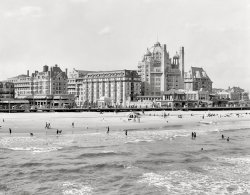
- Buried at Seashore: 1905
- Atlantic City, New Jersey, circa 1905. "Beach bathers and Steel Pier." And a girl we'll ... bulldozer toward the half-buried woman.
(The Gallery, Atlantic City, DPC, Swimming) ... Posted by Dave - 05/08/2019 - 7:16pm -
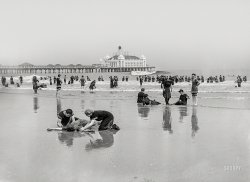
- Over the Boardwalk: 1984
- Atlantic City isn't the only place with a Boardwalk, ya know. Out here in California ... or brick in NJ, like in Cape May or Bradley Beach, but Atlantic City and many other Jersey Shore towns still have the old wooden ... Posted by tterrace - 02/17/2021 - 3:40pm -
![Over the Boardwalk: 1984 Atlantic City isn't the only place with a Boardwalk, ya know. Out here in California we've had the Santa Cruz Beach Boardwalk since 1907. Its Giant Dipper wooden roller coaster is a National Historic Landmark. In another kind of history, back in 2008 its late, lamented Fun House was the location in one of my very earliest Shorpy photo submissions. I took my 1984 shot on 35mm Kodacolor VR 100 with my Konica Autoreflex T. View full size.
Who Wears Short Shorts?Surprisingly it doesn't look all that much different than a similar scene today, except for the length of the men's shorts!
They're showing a lot of legUsually you can judge the approximate year of a picture by female hairstyles and attire. But here it's the males that date this photo to the 1980s.
More legShorts were shorter back then.
Under the PavementIt's "down by the sea" alright, but a "boardwalk"? Where's the "boards"? Looks like pavement.
I know, I know: "Boards?!? We don't need no stinkin' boards!!!"
Konica: Built Like a TankIn 1972 my six year old Hanimex rangefinder camera was stolen. Actually, I left it in a phone booth (remember those?) for a few minutes and when I returned it was gone. I purchased a Konica Autoreflex T as a replacement, and took many thousands of photos over a forty year period. It was very reliable, and was rebuilt twice. I used mostly Kodachrome 25 and 64 colour slide film, but also Agfa, Kodak and Ilford black and white.
I went digital in 2010, and this photo of my Konica was taken with a Canon ELPH 360HS, my third digital camera. I did my own darkroom work for many years, but I enjoy the ability to edit photos on my computer without the use of chemicals. A scan of a Kodachrome slide produces a richer photo than a digital image. My father's Kodachromes from 1954 have held up very well. The Konica weighs just over 2 pounds, while the Canon is just under 8 ounces.
Nice JobOn reproducing a 1984 Kodacolor Mr. Terrace.
Did you use the negative or print?
[This is a scan of the negative. -tterrace]
Medical emergency or fight?I wonder what is going on to the left of the red and green building in the middle of the picture? It appears to be two or three people on the ground in a pile. A few people around them seem interested but not the masses.
[Good question. -tterrace]
Where are the boards?I'm kidding, and it's a terrific picture! We have beach-side promenades made out of concrete or brick in NJ, like in Cape May or Bradley Beach, but Atlantic City and many other Jersey Shore towns still have the old wooden boards, like Atlantic City, Asbury Park. Some towns have begun replacing the wooden boards with trex composite planks, which last longer and warp less, but something's lost when you "upgrade" that way, and it doesn't sound or feel the same when you're walking or riding along.
SocksThe men's shorts were short but the other 80's giveaway is the length of the socks, especially the ones with the 3 colored stripes at the top.
A different era.A couple of guys have picked out something nice at that “Women” shop. Man, to have lived in a time like that.
Man, to have livedThere are many Shorpy commenters who wonder what it would be like to be on a particular 1905 Manhattan street or at the 1922 Washington DC tidal basin. No one is alive to give a first-hand account. I like the 1941 Virginia crowded-bed photos that prompt personal memories from some commenters. But for Winstrol to say, “Man, to have lived in a time like that” about a scene from 1984, that makes me say, Hey! – I was 27 back then. (And I’m only 63 now.) So it’s not like that’s ancient history, you young person. We pre-oldsters remember the times of tall socks and short shorts and bad music and ridiculous hair. I think there was a hole in the ozone layer but global warming wasn’t a thing yet. Reagan was in his first term and Russians were bad commies. Cars were unremarkable. Living in the eighties was easy because although I was just a kid in the sixties, I knew I owed an eternal debt to all those hippies and freaks and protesters who did the heavy lifting that handed me sex & drugs & rock ‘n’ roll on a platter.
Eye-catchingThe girl in the foreground with the white tank top and purple shorts, and the one just to the left of her in the blue top and a couple of steps behind her. The prevailing female hairstyle seems to be mostly shoulder length perms.
(ShorpyBlog, Member Gallery, tterrapix)](https://www.shorpy.com/files/images/santa_cruz_c1984_035_SHORPY.thumbnail.jpg)
- 12-Hour Photo: 1901
- Circa 1901. "The Islesworth and Virginia Avenue, Atlantic City." Much interesting signage among the hotels, our favorite being the ... Posted by Dave - 12/10/2013 - 10:35am -
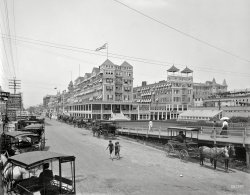
- A Lion in the Sand: 1900
- Continuing our sojourn by the sea: Atlantic City circa 1900. "Sand modelling." 8x10 inch dry plate glass negative, Detroit ... down with the crash of 29 or soon after.
(The Gallery, Atlantic City, DPC) ... Posted by Dave - 08/24/2011 - 1:32pm -
![A Lion in the Sand: 1900 Continuing our sojourn by the sea: Atlantic City circa 1900. "Sand modelling." 8x10 inch dry plate glass negative, Detroit Publishing Company. View full size.
Yesterday's headlinesSeeing the phrases "There is hope" and "Domestic Troubles" piqued my curiosity. Apparently this is an allegory about the 1900 presidential election, and in particular about William Jennings Byran, the populist who was reputed to have taken over the Democratic Party. The elephant at the top is a dead giveaway.
Mixed Bag of SandThe sculptor seems to be revealing his inner conflicts. Is that Fred Nietzsche? A male lion and a female snake in domestic conflict with the proverbial elephant in the room? I'll leave it to the Shorpy historians to explain what its about. On a lighter note, I thought the kid crawling in the sand on the lefft looked like an lizard rushing over to see whats going on.
Like sand through the hourglassThis photo immediately brought to mind sand-sculpting a little more local to me in space and time, at Revere Beach in Massachusetts.
The artistic style is strangely familiar, and the "big theme" choices for subject matter are similar. 1900's "Domestic Troubles" could easily be placed right next to 2009's "Ouroboros: Life, Rebirth, and Stuff", the second-place winner at the annual competition on Revere Beach.
http://reverebeachpartnership.com/nessf07/index.htm
Bryan's Populists were depicted as a snakeIn a popular cartoon of the time, depicting the Bryan wing as devouring the whole of the Democrat party -- represented by the Donkey then as now. I think the sculpture may be showing that the snake is killing the lion, and thus crushing the notion of the King of the Beasts cowardly or not. Embraces of negative caricatures are familiar in our politics. For example, Martin Van Buren's faction in New York State adopted the name "bucktails," which was originally meant as an insult to show them running away.
Concerning PoliticsThis is a stretch, but here I go anyway. The man is the Democratic presidential candidate for that year who has an anti-imperialist platform and the Republican press mimic him as "the cowardly lion": William Jennings Bryan (The hair is artistic license). The lion has killed the elephant: William McKinley and party. The snake is the devil himself as portrayed in the book of Genesis.
Pardon me for wishing myself good luck with this one.
Images in the sandThe 1900 election explanation sounds credible enough, but person in the "There Is Hope" sculpture has way more hair than Jennings ever did. On another note, that sure looks like a rather large lizard scrabbling along the sand in the upper left section. Is it, or is it an optico/photographic illusion?
Update: on the other hand, maybe I should read all the comments before commenting. But hey! I just want to fit in here.
[He/she/it should be familiar to cryptozoologists everywhere. - Dave]
No sweat tterranceThat long hair bothered me too until I thought of him being
represented as a biblical prophet.
Only his sister would call him a lizardThat's because little boys can be so annoying!
Dave, thank you so much for this ongoing shore series. I'm from New Jersey, and I'm inordinately proud of my little densely-populated state of cities, shorelines, farmland, highways, and forests. We're tremendously diverse and remarkably tolerant, for the most part, being descended from Quakers at one end and Dutch merchants at the other. The joie de vivre on the faces of these bathers, the care and engagement with the world that you see in these sand sculptures, all make me proud of my 250-year New Jersey heritage.
Bravo, Garden State!
With all that hairI think this may be Robert La Follette, another Populist orator of the time.
Do you know the Munyon ManMunyon Remedy Company out of Scranton, PA. 'There is Hope' for consumptives. I recognized Mr. Munyon from some old shares of stock I have.
Company went down with the crash of 29 or soon after.
(The Gallery, Atlantic City, DPC)](https://www.shorpy.com/files/images/4a18212a.thumbnail.jpg)
- Funniest Place on Earth: 1914
- Atlantic City circa 1914. "Bathers in front of Chalfonte Hotel and Steeplechase Pier." ... Or were they just not very popular?
(The Gallery, Atlantic City, DPC, Swimming) ... Posted by Dave - 01/05/2017 - 11:47am -
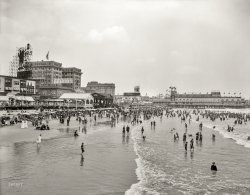
- Marlburro Country: 1905
- ... The Jersey Shore circa 1905. "Ponies on the beach at Atlantic City." In the background, the Steeplechase and Steel piers. Closer to the ... Posted by Dave - 04/12/2018 - 4:00am -
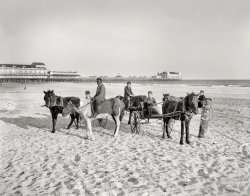
- The Passion of Pola: 1921
- ... in 1921. - Dave]
9:30 The tall building, the Atlantic Building, is the site of the original 9:30 Club. That venue drew big ... of this type of architectural preservation throughout the city.
View Larger Map
+88 Below is the same view from ... Posted by Dave - 08/13/2013 - 3:50pm -
![The Passion of Pola: 1921 January 1921. Washington, D.C. "Metropolitan Theater crowds for 'Passion.'" The line outside Crandall's Metropolitan on F Street to see Pola Negri in "Passion," aka "Madame DuBarry." National Photo Company glass negative. View full size.
A TalkiePassion was an early "talkie." These people are probably about to see their first motion picture with sound.
[Where'd you get that idea? There were no "talkies" in 1921. - Dave]
9:30The tall building, the Atlantic Building, is the site of the original 9:30 Club. That venue drew big names in music in the 80s and 90s before moving to its new location up on V Street.
And before the Google street views show up, the architectural details of the two short buildings on the left have all been reconstructed. It looks like the original is still intact, but that's not the case. Metal storefront, windows hoods, etc. are all new.
Re: A TalkieAnonymous might have confused Pola's "Passion" with Norma Talmadge's "Du Barry, Woman of Passion" from 1930. Reportedly a terrible film. "Passion", which was also about Madame Du Barry, was an early film of famed director Ernst Lubitsch.
Sprechen Sie Englisch?If it had been a talkie, the film would've been in German, since it was made in Germany by the great Ernst Lubitsch. Pola Negri, by the way, was offered the role of Norma Desmond in "Sunset Boulevard," but refused to play a washed-up star. Her last screen appearance was in 1964.
A different viewHere's a picture I took of these buildings in 2001. They were knocked down, and only their facade was left standing. The pic is from behind, with the Atlantic building on the left. They've since been integrated into totally new buildings, one of which I believe is an entrance to Ford's Theater, which is around the corner.
Streetcar tracksThe streetcar tracks look to be for cable cars with the center "slot." There are no overhead lines for a typical electric connection for an electric streetcar. I wonder if they were still in operation at the time of this photo.
[Downtown Washington's electric streetcars had an underground power supply. - Dave]
After 9:30That was a great old space for the 9:30 Club. Even if it was a firetrap.
Practically that entire block was demolished a few years ago except for the facades.
Upstairs in the WhitakerUpstairs in the Whitaker building, there is a man with a derby and a cigar poking his head out behind the Irish lace curtains. He looks up to something.
Also, behind the boy with the bike is a motion-blurred kerfuffle. It's probably a gesticulating meet-and-greet; it's fun to see it caught in time.
Guy Noir Lives!On the third floor of the Whitaker Building one man is still trying to find the answers to life's persistent questions!
Hommes pour PolaTwice as many men as women lined up for Pola -- could it be because the film is about the private life of a well known courtesan who was Louis XV's mistress until her death on the guillotine? I think it was banned in Finland.
Farther Upstairs at the WhitakerIf you look in the windows above the curious gentleman, you will see two small posters for Harding and Coolidge. The Harding inauguration would be coming up on March 4.
PeeragePerhaps the curious man is Norman Whitaker, wondering why no one is coming upstairs to get a patent. Or maybe he's like me, gazing at the sidewalk as disembodied feet go walking by.
Crandall's MetropolitanHeadley describes the Metropolitan, 932-936 F Street, as Harry Crandall's flagship theater, with a seating capacity of 1,500. Opened in 1918 and remodeled in 1926, it premiered the first sound picture in Washington, "Don Juan" starring John Barrymore. Last screenings were in 1966.
Norman T. WhitakerRan across Internet information on a Norman T. Whitaker who: graduated Georgetown Law School, was a patent attorney, in 1922 became Assistant Secretary of the Interior, was later disbarred, convicted of several unsavory crimes, including extortion connected with the Lindbergh kidnapping case, and served time in Alcatraz, where he became a friend of Al Capone. Oh, he was also an outstanding chess player, becoming an International Master, and spent the "last years of his life were spent driving around the country in his Volkswagen Beetle playing in weak tournaments he could win in the South." He continued to complete actively until his death at age 85 in 1975.
900 Block F St: TodaySomehow this photo has escaped a link to Google Streetview of a contemporary image. I don't know how well other cities do this, but D.C. building/zoning permits do (thankfully) appear to enforce a preservation of historic street-level facades. Now, mainly owing to all the Shorpy photos, I am much more aware of the numerous examples of this type of architectural preservation throughout the city.
View Larger Map
+88Below is the same view from September of 2009.
(The Gallery, Bicycles, D.C., Movies, Natl Photo)](https://www.shorpy.com/files/images/29796u.thumbnail.jpg)
- Hotel Windsor: 1900
- The Jersey Shore circa 1900. "Hotel Windsor, Atlantic City." At left, the Traymore. 8x10 inch dry plate glass negative, Detroit ... Posted by Dave - 08/08/2012 - 3:11pm -
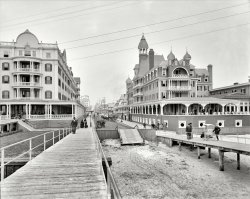
- Leisure World: 1906
- Atlantic City circa 1906. "Boardwalk and big hotels (the Marlborough-Blenheim and ... lovers lounging under the boardwalk.
(The Gallery, Atlantic City, DPC, Swimming) ... Posted by Dave - 03/23/2016 - 6:07pm -
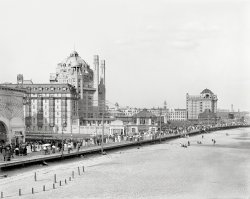
- The Sponsored Shore: 1910
- Atlantic City circa 1910. "The beach and Steeplechase Pier." Brought to you by Cremo ... 8x10 glass negative. View full size.
(The Gallery, Atlantic City, DPC, Swimming) ... Posted by Dave - 03/12/2014 - 2:12pm -
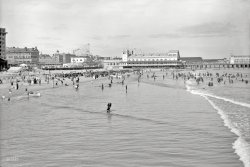
- A.C. Express: 1905
- Atlantic City circa 1905. "Giddap." These lovely lasses, last spied "Teasing," just ... 5x7 glass negative. View full size.
(The Gallery, Atlantic City, DPC, Swimming) ... Posted by Dave - 07/25/2012 - 3:12pm -
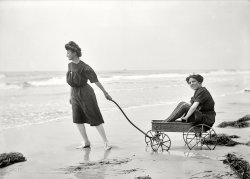
- Futurama: 1962
- ... if today I could purchase a real ticket to fly across the Atlantic into Idlewild, and find myself in this rather beautiful lounge, with ... Shorpy's old friend, the Rockaways. A Buddy and I went by city buses to the airport very early in the morning. We wandered around the ... Posted by Dave - 01/23/2013 - 11:59pm -
![Futurama: 1962 August 29, 1962. New York. "TWA terminal, Idlewild. Union News restaurants -- Lisbon Lounge II. Raymond Loewy." Nowadays of course we have Sbarro's and Panda Express at the airport, but 50 years ago people had to make do with this. Large-format safety negative by Gottscho-Schleisner. View full size.
IdlewildLiving under the flight path of JFK (bad weather days only, thank God), I'd often wondered about the name change; seems it was a rather prosaic moniker for the golf course the airport replaced.
Nevertheless, JFK has, in my mind, been under construction almost continuously since it opened; having been here numerous times, whether departing, arriving or pickup/drop-off, getting around the airport is a never-ending challenge -- but I always enjoyed the unique architecture of TWA, as well as the PanAm "spaceport" with its rooftop parking; even the British Airways terminal is interesting in the twilight.
Ya gotta love the '60s.
Idlewild RedeauxI too was there, but much younger. I do remember the B-47's that were there (if you saw Jimmy Stewart in "Strategic Air Command" he was flying a B-47). I also remember the main (and then only) wooden terminal (later torn down). Things have changed greatly since then, not all ways for the better.
Prolific designerRaymond Loewy designed everything from locomotives to vacuum cleaners to cookware, spanning six decades. His Studebaker designs are especially iconic and amazing. I had no idea he (or at least his firm) designed restaurants, too.
Bar TilesAs "space age" as everything looks, the tiles that make up the front of the bar just don't seem to fit in to me.
Yet another Mad Men referencebut I can totally see Sterling, Cooper, Draper, Price sitting here drinking Martinis and hitting on Stewardesses.
What's in a name?There is something rather beautiful about the old name of this airport ... Idlewild has a soft sound to it; it's lyrical, and summons visions of meadows and a more graceful era; and I wish that I had flown in or out of there when it had that lovely name.
I suspect that Dave's comment that '50 years ago people had to make do with this' is a trifle tongue-in-cheek; if today I could purchase a real ticket to fly across the Atlantic into Idlewild, and find myself in this rather beautiful lounge, with place settings that suggest they served real food, I would reserve my flight in a heartbeat.
I know I am suffering an irrational and merely romantic longing for something long gone.
InterregnumI've never been to Idlewild/JFK, but my experience in airports suggests that the Panda Express era was an improvement on the couple of decades that followed this idyll. Remember the proprietary no-name snack stands with no selection and sky-high (!) prices?
Also, I think we're well into a new era, with relatively interesting food-court options from real restaurateurs.
Still, I'd give anything for a quick jaunt to '62 ...
Not irrationalI know I am suffering an irrational and merely romantic longing for something long gone.
Your romantic longing is certainly not irrational.
This was an inviting place, and I can imagine strolling in while on a layover and smoking a cigarette, and sitting down at the bar for a Jim Beam on the rocks and a steak dinner. I'd meet someone sitting nearby who was also traveling, and we'd exchange a story or two while idling for our flights.
Union News CompanyWas sort of the eastern version of the Harvey Houses on the Santa Fe. I never knew they were in airports, or had anything this fancy. I remember the Union News restaurant in the Augusta (Georgia) Union Station, and there was even one at the station here in Florence, SC. When Charleston (SC) Union Station burned in a spectacular 1948 fire, it was said the fire started in the Union News Company kitchen. (For years thereafter, employees joked that the Atlantic Coast Line RR had paid Union News to burn the building down for them.)
I believe Union News also employed the "News Butches," who rode trains carrying big tubs of snacks, beverages, and of course newspapers. The tubs looked so heavy, and the "Butches" so tired and worn down, that I always tried to buy something from them, even if I didn't really want anything.
I've been through JFK three times in my life.Twice in 1983, a month apart, and once last year.
The airport has definitely not improved in the intervening years.
Food might be more diverse, and with at least slightly more name brand restraunts, but I do believe that I would have been happier all three times being able to set down in this setting, and enjoy a nicer meal.
And it's DEFINITELY less crowded in this picture (there should be 50-60 people here based on the airport today!); every time I've gone through the airport, it feels like I'm getting closer and closer to seeing someone sell Soylent Steaks. Make room, make room!
Idlewild OpeningI remember being at the dedication of Idlewild Airport in July 1948. I was 15 years old.We were living in a summer bungalow at Shorpy's old friend, the Rockaways. A Buddy and I went by city buses to the airport very early in the morning. We wandered around the place, taking in the aircraft and anything else that looked interesting. We decided to eat our homemade lunches around 10AM. There was an area set up with viewing stands like the bleacher section of a ball park and climbed to the top row and sat there. A few moments later a contingent of NYPD cops gathered in front of the stands. They looked up and saw us and let us be. Soon after, some civilians arrived they saw us as well. They called to us to come down and we did. They were US Secret Service and were there to protect President Truman who was to speak at the Dedication. One of them pointed to an area if front of us and told us we could stay there. Eventually the ceremonies started and about an hour later the President spoke. I don't remember anything he said but it was a thrill just to be there. We got back to the beach later that afternoon, just in time to view a spectacular air-show.
Days beyond recallI landed at Idlewild in 1957, when I came here as an immigrant, and used it twice a month for business flights to California in the early Sixties. Back then, first class to the coast only cost you an extra $15 and passengers were given a choice of steak, lobster, or something else. People dressed nicely for their flights, luggage allowance was generous, and it was just a pleasure to fly. For a while, I could even walk from my office to the Pan-Am building in NYC, take an elevator to the roof and board a helicopter that whisked me to my terminal and gave me a stunning view of the Statue of Liberty.
Here is what the coach lounge looked like on American Airlines, so you can imagine how amazing first class was (it had a cocktail pianist).
Something is missingI distinctly remember the acrid smell of cigarette smoke wafting in the airport in 1983. Obviously, there was no such smoking area in 2012. However, I'm shocked at what's missing from this photo on second deep look: no ashtrays. In 1962. Even my folks, non-smokers, had ashtrays around into the early 1970s for friends who smoked.
There's A Holdup In The Bronx . . .I'm sure someone remembers the Idlewild reference in that TV show theme song!
Raymond Loewy did design some wonderful items. I had for years an old twin-lens reflex camera he had designed; it was a soft green color and looked way spiffy. I gave it to a friend who couldn't live without it and have regretted it ever since!
What's on TV?Too bad we can't tell. Dang refresh rate!
[Looks like it's focused on the flight departure board. - tterrace]
Car 54 Where Are You? There's a holdup in the Bronx,
Brooklyn's broken out in fights;
There's a traffic jam in Harlem
That's backed up to Jackson Heights;
There's a scout troop short a child,
Khrushchev's due at Idlewild!
Car 54, Where Are You??
Khruschev's due at IdlewildToday it would be Putin's due at JFK.
TilesAt least they have a food theme. but they do look slightly olde-fashioned in contrast to the rest of this glorious eatery.
I spy something out of placeThere's a reflector lamp poking its head in on the far right of the frame, there's another one hidden behind the last three headed lamp on the left, you can clearly see the reflection of this one in the window. These are certainly not part of the decor so they must have been put there by the photographer for extra light.
(The Gallery, Eateries & Bars, Gottscho-Schleisner, NYC)](https://www.shorpy.com/files/images/SHORPY_5a28549u.thumbnail.jpg)
- Shore Patrol: 1905
- Atlantic City, New Jersey, circa 1905. "A life saver on the lookout." 5x7 inch dry plate ... Publishing Company. View full size.
(The Gallery, Atlantic City, DPC, Swimming) ... Posted by Dave - 09/15/2016 - 11:57am -
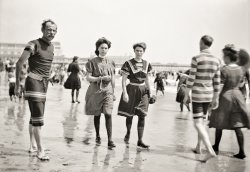
- Seaside Casino: 1905
- The Jersey Shore circa 1905. "Brighton Casino, Atlantic City." 8x10 inch dry plate glass negative, Detroit Publishing Company. View ... Posted by Dave - 12/28/2017 - 12:37pm -
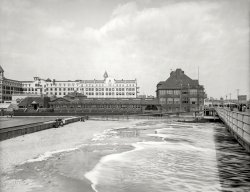
- By the Seashore: 1904
- Atlantic City, New Jersey, 1904. "Boardwalk and Hotel Chalfonte." Demolished in 1980 to ... inch glass negative. View full size.
(The Gallery, Atlantic City, DPC, Swimming) ... Posted by Dave - 05/29/2017 - 8:11pm -
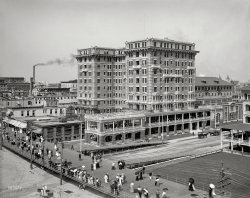
- 1942: Family No. 1319
- ... this to author Jan Jarboe Russell's "The Train To Crystal City." It is a very well-written and compelling read.
To be sure, that this ... population and those ships were needed desperately in the Atlantic at that time.
There's More to the Story Reading from the ... Posted by Dave - 03/10/2021 - 11:30am -
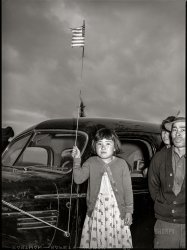
- C.H. Javins: 1926
- ... local to DC. The most interesting is the flatfish, an Atlantic halibut, a species now almost extinct. They were once plentiful ... exciting. Sometimes it was markets, like this, sometimes city streets with stalls and vendors, sometimes factories - working or ... Posted by Dave - 07/13/2011 - 9:56am -
![C.H. Javins: 1926 September 1926. "Thos. R. Shipp Co. -- C.H. Javins stand." The Charles Javins seafood stand in our second look today at Washington's old Center Market. National Photo Company Collection glass negative. View full size.
Where's the flypaper?For this photo, as for the one of the meat purveyor, there are no coils of flypaper festooning the ceiling. Perhaps they removed them for the picture; or it was midwinter.
[What's the first word of the caption? - Dave]
The Center MarketMust have smelled like the rendering plant in this place. The stench must have knocked people down in the summer months. Thank God I was not around to visit this place.
When did Americans get so wimpy?Looking at this picture, from less than a century ago, with the whole chickens, heads, feet and all, makes me wonder when American got so wimpy about such things. I cooked chicken and beef hearts, chicken gizzards and all kinds of livers all those years my ex was in school, but I could never get near chicken feet and heads. Makes me kind of ashamed, really, that we Americans let anything like that go to waste.
Later:
Thanks, OTY! I knew that people all over the world used those parts, but I have never seen them offered for sale here in America. I have a recipe in The Black Family Reunion cookbook for chicken feet stew, but I don't even know where I would get the chicken feet, if I wanted to try it. African American women have always had a great talent for taking the parts that no one else wanted and making something tasty and nutritious for their families out of them!
Fish or MeatAt last, I learn why there are no fish hamburgers.
Advertisement, Washington Post, Mar 17, 1924.
Differences and Similarities
Between Fish and Meats
Though fish and meats are commonly considered as different articles of food, they are nevertheless for nutritional purposes almost the same thing. The similarities are more striking than the differences. FISH will serve the purposes of MEAT in every particular and for an indefinite time. The choice is mainly in taste, price and variety.
Still, if argument need to presented, fish will be found there and ready. One difference to be noted is in the physical properties. The connective tissues of fish are gelatinous, and on brief cooking, without chopping or pounding become so tender as to fall to pieces. This fact alone explains the easy digestibility of fish. It also explains why there is no such thing as a fish hamburger: You don't need to grind it as a preliminary to chewing it.
FISH MEAT generally does not hold blood, and is therefore usually white. FISH has valuable minerals, vitamines and other constituents. Fish that are not too fat are always easily digestible.
In summary, the main fact from your point of view is that you can have a refreshing change to sea food, introduce variety into your diet, and be sure that your food is rich, wholesome, adequate and fully justified by scientific research. You will make no mistake by getting the sea-food habit.
If you want the best of Fish and Sea Foods, buy from the following wholesale and retail dealers, who are known for their fair prices and dependable service.
…
CHAS H. JAVINS & SONS,
Center Market, B St. Wing, Main 8649
…
Chicken of the SeaI always thought "Chicken of the Sea" referred to tuna.
Sorry, Charlie!
Hangin' OutThe fish hung on the rod include an Atlancic salmon and four striped bass, the latter found in waters local to DC. The most interesting is the flatfish, an Atlantic halibut, a species now almost extinct. They were once plentiful throughout the north Atlantic all the way down to New Jersey, and are the largest of the halibut species. In addition to being quite tasty, the Atlantic Halibut was prized for its liver, which produced an oil rich in vitamins.
Nearest the FanI'll have two fancy chickens, nearest the fan that's operating if you please. Somewhere along the way us modern folk must have lost our immunity to samonella.
A mysteryI still can't figure out -- with all that great food so readily available back then, why was the life expectancy average so low? 'Tis quite the paradox.
AromasBet you didn't have to see Mr. Javins to know whether he was in church with you.
FreeE. coli!
85 years in the futureWhen Shorpy shows pictures of today’s meat and fish markets 85 years in the future. Won't be around to see that one, I wonder what comments will be made about today’s unsanitary and unhealthy conditions. I feel the comments will be similar to those previously posted.
Today's KickerThe kicker is there are thousands of markets, just like this one, operating today and tomorrow all around the world. And one doesn't need to travel all that far to find one: they are common in Central America.
Indeed this is how a great proportion of the population still does their daily shopping, along with a second trip out to the bakery.
Interesting is there usually is no strong "aroma" and the markets generally smell like your neighborhood butcher shop. Today, and probabl yesteryear as well, the markets are given thorough cleanings at the end of each day; after all, they must give a good impression to tomorrow's shoppers.
There may be some visual objections but I would rather enjoy that fish caught early this morning rather than one which has been sitting around a modern supermarket for a week.
Center MarketC.H. Javins & Sons had been selling fish since at least 1882 in Washington. At Center Market in stalls 229-48 and 280-82 (1923 Polk directory). Possibly this is 229-48, since behind Javins appears to be Gus G. Gillespie, produce, who had 249-52. Likely that is Chas. W. Smith, produce, in 199-204 to the right of Gillespie. More here on Center Market at the bottom of the page, and here.
Paper CansThose boxes in the foreground are labeled "Paper Cans." What are those, and why don't we hear of them any more?
This place looks excitingI guess I'm getting old, but I remember my folks (mainly my dad) taking me to places that looked like this when I was little - busy, dirty, crowded with stuff everywhere. They were very exciting. Sometimes it was markets, like this, sometimes city streets with stalls and vendors, sometimes factories - working or abandoned. He liked old repair shops with spare parts everywhere. His shop in the basement was festooned with stuff everywhere like this place.
Sometimes we would get an outboard motor fixed, sometimes he would buy me a whole salami. It was always fun.
My mom only took me to clean, boring places.
Rooster Combs and Chicken FeetFor Noelani's reply, rest assured that the items in the title do not go to waste. Rooster combs are used to make a medicine called hyaluronic acid that is injected as a lubricant for osteoarthritis patients, some say it works, some say not sure. Chicken feet are used by multiple ethnic groups including Asians, Eastern Europeans, Africans, Latinos and others for delicious stocks, soups and regular eating and are not dirty because the outer skin on the chicken feet is removed (much like shrimp shells). Beneath that skin is juicy, fatty, very tasty chicken morsels and lots of bone. Very little, if anything, goes to waste among poor populations. I'm not sure about the beaks.
Paper CansI believe you can see them in action right now if you peer into the ice cream cooler at any Baskin Robbins store. They have been in use there for a very long time. I remember a small advertising campaign there in the early 1960s in which they tried to encourage patrons to take home the hosed-out empties and reuse them as storage containers.
One suggestion for the frugal proto-Martha Stewarts and starving students was to cover them in wallpaper to make a decorative waste basket.
I will have to stop at a BR tonight for some field research to verify current use and see if the company noted still is the supplier.
[You can see them in the freezer case at your grocery store. "Paper cans" are the waxed cartons that ice cream is sold in just about everywhere. Also used as deli cartons for potato salad and such. - Dave]
(The Gallery, D.C., Natl Photo, Stores & Markets)](https://www.shorpy.com/files/images/32963u.thumbnail.jpg)
- The Alamac: 1913
- Atlantic City circa 1913. "The Alamac (formerly Young's Hotel), Boardwalk at Tennessee ... Publishing Company. View full size.
(The Gallery, Atlantic City, DPC) ... Posted by Dave - 01/30/2020 - 12:27pm -
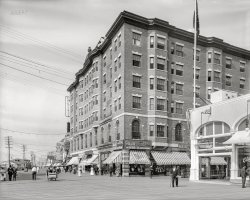
- Missoula: 1942
- ... Waterworks Hill Surviving buildings include the former Atlantic Hotel (including its wall sign), the former Northern Pacific Railroad ... for the benefit of others using the spot to look over the City, or as a trailhead.
A bunch of balloons? Nice view of the ... Posted by Dave - 10/23/2021 - 11:39am -
![Missoula: 1942 April 1942. "Missoula, Montana." Medium format acetate negative by John Vachon for the Office of War Information. View full size.
The turntable is still thereBut the buildings have gone.
https://www.google.com/maps/@46.8761404,-113.9892682,3a,60y,244.79h,95.25t/data=!3m6!1e1!3m4!1s1ReWcT0iuv0JuXq_HnvBYw!2e0!7i13312!8i6656
TurntableThe roundhouse is gone, so now we can see the turntable. However, it was not housed or sheltered. It was an open air table, like almost all of them were.
Three C's DeploymentMy dad was in this area a few years earlier with the Civilian Conservation Corps. I suspect it looked pretty much the same when he was out there.
Changed, but not totally differentThis Street View is taken from what is now Interstate 90, also called MT-200. The main body of the train station is still on the other side of the tracks but the house sheltering the turntable is gone. At left the cupola atop the Missoula County government building is still visible.
The roundhouse is gone - - but the turntable is still there and in use.
Round? Yes. House? Nope. Poor trains, nary a roof over their heads.
Spare tires?There are several piles of large rings in the foreground, to the left of the locomotive barns. Are those spare tires for the drive wheels?
The view from Waterworks HillSurviving buildings include the former Atlantic Hotel (including its wall sign), the former Northern Pacific Railroad Depot, St. Francis Xavier Catholic Church, and the Missoula County Courthouse. Vachon took this picture from "Waterworks Hill," which is getting a major upgrade (including its own parking lot) for the benefit of others using the spot to look over the City, or as a trailhead.
A bunch of balloons?Nice view of the now-gone roundhouse. Everything here is fairly recognizable except for the odd looking load in this gondola. Anybody know what this is? And there is the oddly proportioned caboose next to the gon.
[The load of logs is behind the gondola. - Dave]
The Paint on the Building ...The Atlantic Hotel and Coca Cola signs painted on the side of building located at 519 N. Higgins Ave are both still there.
Missoula StationMissoula Station is listed on the National Register of Historic Places in 1985, as the Northern Pacific Railroad Depot. Near the depot is the preserved Northern Pacific #1356 4-6-0 steam locomotive.
If you know, you knowEvery time I hear or read the words "Missoula Montana" I think of that scene in Twin Peaks where Ray Wise (as Leland Palmer) is in the process of murdering Sheryl Lee (as Maddy Ferguson, his niece) and he shoves her into a mirror bellowing "You're Going Back ... to Missoula ... MONTANAAAAAAA!"
(The Gallery, John Vachon, Landscapes, Railroads)](https://www.shorpy.com/files/images/SHORPY-8c21943a.thumbnail.jpg)
- Sootyscape: 1904
- ... zones, including Boston, milk was carried from farm to the city in special refrigerator cars cut into passenger trains.
Switches! ... South Station's reconstruction in the mid-1980's.
The Atlantic Street wing of the station (visible at left) was torn down before ... Posted by Dave - 08/05/2012 - 6:23pm -
![Sootyscape: 1904 Boston, Massachusetts, circa 1904. "Yard and tracks, South Terminal Station." 8x10 inch glass negative, Detroit Publishing Company. View full size.
Rough (rail)road aheadIf you ask me, that switched diamond junction in the lower-right looks a bit treacherous. Maybe if you get up enough speed and Evel Knievel it to the next track...
NiceReally love the geometry of the tracks. I pass through this station every day on my way to the office in downtown Boston.
What a mess of double slip switches that is! Those switches are double slip,meaning that each one handles the duties of two normal switches.
Puzzle SwitchesThese are "double slip" or "puzzle" switches. They combine four switches and a diamond crossing in only slightly more track length than a single switch or crossing. Very common at big passenger stations, due to the tremendous space saving, but hard to maintain, thus very rare outside that context.
I hand built one in HO some years ago, doubt that I will ever build another. I count 28 of them in the picture, plus many conventional switches.
Handling all those switches isn't that stressful, since there is a mechanical interlocking frame in the tower to prevent lining up conflicting routes, and the switches are thrown pneumatically. There is a large track diagram in the tower, with every switch and signal numbered, to use as a guide. However, keeping trains moving in and out efficiently is highly skilled work, little different from air traffic control. These tower operators would "have a lot of whiskers," or high seniority.
It appears that at lower right, the ramp track to the lower level was in the process of being abandoned, I vaguely remember reading references to that, apparently the lower level platforms didn't work out as planned. There is also evidence of some track rearrangement in the form of extended ties and switch machine parts at lower center, just beyond Signal Bridge 8.
Regarding the cars at the left, passenger trains were the airliners of the day, and carried much more than passengers - mail, express parcels (Railway Express and its competitors, the FedEx of the era), and perishables. In many metro area commuter zones, including Boston, milk was carried from farm to the city in special refrigerator cars cut into passenger trains.
Switches!Being in charge of switching all those rails correctly, every time, must have been one heckuva stressful job.
And probably sold a lot of headche powder and Bromo Seltzer, too.
Mail?I'm curious what those railcars on the left would be used for.
South StationWonderful photo of a building that still exists. You can see the back of the clock and eagle which stand above the front of this station. The station has been remodeled, fortunately the facade of the building was preserved, the interior has been changed. Progress, some people say.
Attention model railroadersBet you can't model that switchwork.
The Big SootyThe filth (and smelliness) of cities at the time when coal was widely used for heating and, as here, railroading would astonish people today.
Many buildings in Milwaukee were built in the 19th century from a local clay that's light tan in color -- "cream city brick." But they didn't stay cream-colored for long, thanks to the coal soot belching out of every chimney.
Downtown still has many of these brick buildings, and while many of the more prominent ones have been scrubbed back to their original color, lots of others -— the less important ones, and those on side streets — still have the blackish patina they acquired before about 1960.
South StationSouth Station is only 9 years old in this photo. All 28 tracks are in use, and at this time it is the busiest passenger terminal in the world. It was capable of handling 8 simultaneous train movements through the yard throat.
This picture most likely was taken from the drawbridge control cabin over the Fort Point Channel. This 3-bridge, 6-track structure was only torn down in the past 10 years or so for the Big Dig.
The large train shed was torn down in the 1930's due to the expense of maintaining it and the corrosive effects of the coal smoke on the steel and concrete structure. Not to mention keeping the glass clean.
The building on the left is the outbound express building, which was originally used by a predecessor of the Railway Express Agency. Most if not all the cars in the photo are wood framed cars. The 3 cars behind the leg of the tower are especially ancient with their flat arched roofs.
The building on the far right is the power plant and gas plant for power and lighting of the station (replaced by the South Postal Annex in the 1940's). The coal carrying cars are of the drop bottom gondola type, rather than a true hopper car. The reporting marks on that old tank car is "W.O.W.", and I have no idea what railroad or shipper that is.
The two ramps on the right lead to the abandoned underground commuter loop. This was to be used with electric commuter cars like the ones used on the Nantasket Beach Branch of the New Haven Railroad. This was center 3rd rail, like Lionel toy trains. Safety complaints and projected expense kept the New Haven from electrifying all Boston commuter traffic like it wanted to. South Station was the 1st terminal in the world to be designed for electric trains, and yet it didn't happen until the 1990's for Amtrak on the upper level. The reason for two ramps is that the one on the right was to be used for all Old Colony RR lines to the South and East, while the ramp to the left was to be used for all Providence, Franklin, Needham, Dedham, and Stoughton lines. From what I read, they tried to use the loop once with a steam engine test train, but almost killed everyone on board due to the total lack of ventilation.
The loop station was used at various times as a parking garage and a bowling alley. It was not fully removed until South Station's reconstruction in the mid-1980's.
The Atlantic Street wing of the station (visible at left) was torn down before preservation efforts started. It was rebuilt much wider in the 1980's for a food court. They reopened the same quarries used in the 1890's to get the same color granite. The Summer St. wing was shortened by half for the Stone & Webster tower.
All of South Station was owned by the Boston Terminal Co., which was jointly owned by the railroads that had their own stations replaced by South Station: Old Colony RR, Boston & Providence RR, Boston & Albany RR, and the New York & New England RR. Each RR owned 20% of the BTCo., plus the New Haven RR which owned the OCRR, NY&NE, and B&P (giving the NHRR 80 percent control).
Today, South Station is at 13 tracks, yet it has more scheduled trains than in 1940. There is serious talk of moving the Post Office out, and expanding the track diagram to 20 tracks.
W.O.W. - The Company Became Part of ValvolineThe W.O.W. marking on the tank car stands for the Wilburine Oil Works, Ltd. which was essentially a subsidiary of Valvoline Oil Company (97.04% of stock was owned by Valvoline by 1898).
A predecessor company of the American Association of Railroads (AAR) later assigned the "WOWX" mark to Wilburine rail equipment and they used this mark during the period 8/1920 - 7/1923.
Valvoline Oil Co. used the "WOWX" mark after 7/1930.
Car number 225 shown here is listed amongst Wilburine's holdings in the Official Railway Equipment Register for September 1901. In fact, the next car number, car 226, is the highest number shown.
Originally an abbreviated company name alone was used to designate the owning company of a railroad car. With the growth of international and transcontinental shipping a standardized naming convention was introduced. Most companies retained their old abbreviations, but suffixes were added to differentiate various type of shipping equipment. The letter "X" designates a commercial railcar.
Sometime after 1911 but definitely by 1917 Valvoline was using the VOWX (Valvoline Oil Works, Ltd.) mark and Wilburine was using the WOWX mark.
The W.O.W. car sitting in the yard makes sense because steam trains needed lubrication for their valve gear(s). Valvoline was a principle supplier of this type of oil for more than 70 years.
Valvoline was founded in 1866 as the Continuous Oil Refining Company by Dr. John Ellis. The name “Valvoline” was established in 1868 (VALVe OIL [for the] LINE) and it was trademarked in 1873. Valvoline Oil Works and Wilburine Oil Works finally merged in 1925 according to Moody’s' Industrial Manual (1929 edition, Volume 1).
Is That Fire?!Is that fire shooting out from the chimney of the tall building on the far left, or is it just the result of a deteriorated negative? If it's fire, there must be a lot more going on inside the building that can't be seen.
(The Gallery, Boston, DPC, Railroads)](https://www.shorpy.com/files/images/4a11368a.thumbnail.jpg)
- Prairie Schooner: 1915
- ... Island. I hope they didn't just drive off a pier into the Atlantic.
Boosting the Eden of NYC I noted the curious geographical ... Prairie Schooner is Going to S.F."
Driving up to the City Hall yesterday in an old-fashioned prairie schooner drawn by two horses, ... Posted by Dave - 08/27/2012 - 2:41pm -
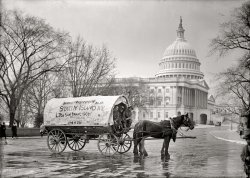
- Ironclad: 1862
- ... of the Federal Navy, and seaborne expeditions against the Atlantic Coast of the Confederacy. Wet collodion glass negative, left half of ... ?) 1862. The location is in the James somewhere around City Point (modern Hopewell, Virginia). The paymaster William Keeler wrote his ... Posted by Dave - 04/04/2008 - 12:25am -
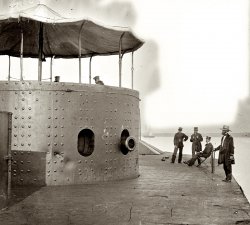
- Dog on the Beach: 1905
- ... I guess that's the difference between Coney Island and Atlantic City.
It's just under the surface here somewhere... If he's ... Posted by Dave - 08/20/2012 - 2:07pm -
